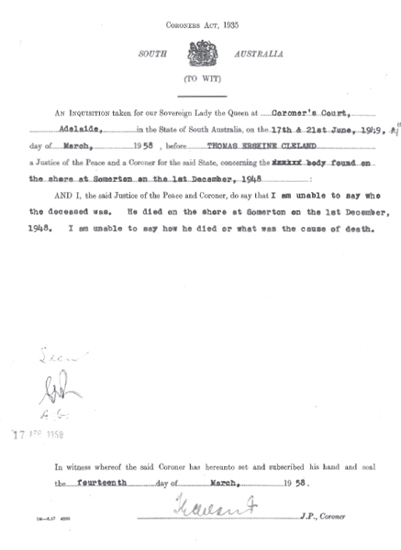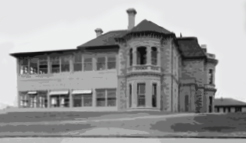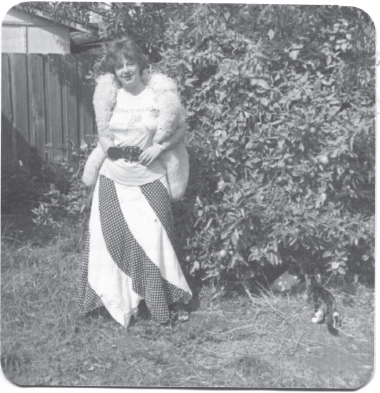Tamam Shud (8 page)
Authors: Kerry Greenwood

Curare is the good old colourless odourless tasteless soluble and undetectable South American poison of Sherlock Holmes fame. It was used along the Amazon as an arrow poison but it had surgical uses in 1948, producing complete shutdown of all involuntary muscles, which rather precludes the heart beating and the lungs breathing. But it wasn't curare that killed Somerton Man.
The indefatigable Cleland investigated other possibilities as well, saying:
Most of the common poisons would give vomiting or evidence of convulsions, something which would have drawn attention to the deceased. Cyanide would be very quick, and no bottle was found, or any smell of cyanide ⦠It is difficult to find any poison that fits the circumstances.
Cleland also dismisses insulin, otherwise a rather attractive cause of death. I have been told by my diabetic sister that one oozes imperceptibly into a diabetic coma. âIt sneaks up on you' are her precise words. But apparently such an overdose would show up in an absence of glycogen in the liver and as abnormally low blood sugar. And it didn't.
The second expert witness, Sir Cedric Stanton Hicks, University Professor of Pharmacology and Physiology, had another suggestion. Not wanting to give anyone who
might read the inquest report any ideas, he wrote a name on a piece of paper and gave it to the Coroner. This might sound excessively cautious but consider the dreadful experience of our own Arthur Upfield, who, sitting around a campfire with some like-minded friends working on the rabbit-proof fence, concocted a murder method which was damn near impossible to solve. All you need to do, instructed Upfield, is to shoot the person, shoot a few kangaroos at the same time, burn all the bodies together and then sift the ashes and remove all identifiable human bits â teeth, buttons, gallstones, bullets. After that you put the ashes through a prospector's dolly-pot, crushing them into powder, allow the powder to blow away on the wind and bury the tin containing the identifiable bits a long way away under an unmarked bush.
One of his audience thought this was such a good idea that he actually carried it out. His name was âSnowy' Rowles, aka John Thomas Smith. Fortunately Rowles blew the original water-tight scheme by stealing the murdered man's goods and being careless with the disposal of the remains. Notably, a wedding ring which had been repaired with the wrong alloy of gold â nine carat on an eighteen-carat ring â clinched the identification. At Rowles' trial, Upfield had to testify that he had invented the murder method as an intellectual exercise. âI shall never forget Mr Justice Draper, the Trial Judge, and how he looked at me on the witness stand,' he told
his interviewer, Eric Clegg. Upfield was about to start his next Napoleon Bonaparte crime novel,
The Sands of Windee
. I find it amazing that he ever wrote anything again.
Returning to Sir Cedric Hicks, his handwriting is just as one would expect from a doctor but it is possible to make out the word âglucosides'. The two varieties mentioned were Digitalin and Strophantin, which are derivatives of
digitalis purpurea
, a heart stimulant which in the old days used to be called foxglove tea. Sir Cedric said that these drugs would have been easy to obtain â for instance, by pinching them from someone with a heart condition â and âdifficult if not impossible to identify even if it had been suspected in the first case'. However, he was concerned that there was no evidence of vomiting because he believed that glucosides would have produced vomiting, convulsions and coma, although he speculated that perhaps the convulsions were minor and people may have walked over the marks in the sand. I was driven around the bend by Sir Cedric, who seemed incapable of making up his mind, but in the end he says that it's glucosides or nothing. And, of course, if it had indeed been nothing, Somerton Man would have been able to attend the inquest and solve all the mysteries himself.
That was all the witnesses had to say about poisons but the Coroner himself made a very interesting observation, saying:
I have been discussing the circumstances on the footing that the body found on the morning of the first December was that of the man seen on the evening of the 30th November. But there is really no proof that this was the case. None of the three witnesses who speak of the evening of the 30th saw the man's face, or indeed any part of his body that they can identify. If the body of the deceased was not that of the man mentioned and if the body had been taken to the place that it was found, the difficulties disappear. If this speculation, for it is nothing more, should prove to be correct, the original assumption that it was the deceased who left the suitcase at the luggage room, bought the rail and bus ticket, removed the clothing tabs and put the printed words âTamam Shud' in a pocket, would require revision.
Now that is a very interesting thought. When the Coroner, who had a fine legal mind, observed that there was no legal nexus between one set of observations and another, he was right. We do not know for certain where Somerton Man was between noon and approximately 7 pm, when he or someone very like him was sitting on the beach, dying. His polished shoes showed Somerton Man had not been trolling around Glenelg in dust all day, indicating that he had probably been inside. But if the man seen lounging asleep on the beach on 30 November,
at the exact spot where Somerton Man was found dead the next morning was not, in fact, Somerton Man, then who was he â and what was he doing there â and where, oh, where was Somerton Man during the night? Was the man on the beach just keeping his seat warm for him?
Let us consider the arguments against the Coroner's theory. One is that the beach was busy. It was a hot night and there were a lot of people around. Even in the early morning men were exercising horses and swimming in the sea. Adelaide may be a strange place but it is not so strange that no one would have noticed a man â or more probably two men â carrying a body down all those steps to the beach and arranging it so neatly that the dead cigarette in the corpse's mouth just dropped onto his collar.
Moreover, if Somerton Man had died of digitalin poisoning but had vomited and convulsed elsewhere, as the Coroner suggests, he would not have had any stomach contents for the doctors to analyse. Nor, having convulsed and vomited in the process of dying, would he have suddenly become peckish for a pastie from the Glenelg railway station pie cart, the only source of any delicacies in Adelaide after about six o'clock, apart from a private home. What's more, as anyone who has ever been nauseous would know, he would certainly not have lit a cigarette. Really not.
Oh dear, I do hope you are not reading this at dinner.
So, an examination of the available information suggests strongly that it was our man on Somerton Beach, all along. The evidence and theories presented at the inquest are comprehensive but inconclusive. Well, almost comprehensive. There was a Crippled Children's Home in Moseley Street, just above the beach, but no one appears to have enquired there about strangers calling and dying inconveniently on the premises.

A page from the Inquest that held the findings of an inconclusive death.
The Crippled Children's Association, established in 1939, set up Somerton Home as a place where the victims of polio could be cared for and receive an education, but in 1948 it was fully occupied by children with polio. A dreadful affliction. Polio killed many and maimed many others, all the way up to the President of the United States, until Salk and Sabin found vaccinations for it, for which we are eternally grateful. I still have the scar but better a vaccination scar than a life in an iron lung. Polio has largely vanished now in the developed world (although it is making something of a comeback as immunisation rates are falling) along with scarlet fever and diphtheria, whooping cough and the other plagues that rid the world of small children throughout history. (One of the reasons why I do not pine for the past, although I write about it, is the number of diseases from which I probably would have died before the age of five. Death puts a bit of a crimp in one's writing career.)

Somerton House overlooked the spot where Somerton Man was found. Strangely, no enquiries were made here to discover any witnesses. It might have been the place of Somerton Man's last supper.
The Crippled Children's Home (also known as Somerton House) was established in an old bluestone house which had belonged to the Bickford family. Later, the Home accepted children with other disabilities including mental disabilities, and was renamed Minda, causing nasty little children to add âYou're a Minda!' to their terms of abuse. But in 1948 only the poor polio victims lived there. They were as bright as buttons â the disease does not affect the mind â but badly damaged. Most of them would be unable to walk, except with calipers. The home has a good reputation. Inmates have written to the disability website in South Australia praising the matron, a World War I nurse called Matron Hacket, who ran the place like clockwork with compassion and intelligence. (This is, by the way, quite unlike the horror stories I have just been reading about the Magdalen Laundries run by the Sisters of the Good Shepherd. I must say it made a nice change.)
A children's home probably went to bed early and would, of course, have had a kitchen, which might have
been the source of Somerton Man's supper, and an infirmary, which might have been the source of those glucosides â and the source of Somerton Man's death, too. But no enquiries were made at the time and it is now really far too late to even try to find out. Besides, even with the trained imagination of a crime novelist, I find it difficult to imagine such a place and such a matron as a haven for murderers or secret spies.
Although stranger things have happened, especially in Adelaide.
Chapter Five
Iram indeed is gone with all his Rose,
And Jamshyd's Sev'n-ring'd Cup where no one knows;
But still the Vine her ancient Ruby yields,
And still a Garden by the Water blows.
The Rubaiyat of Omar Khayyam
, stanza 5
Examining the verifiable facts of the Tamam Shud case has, so far, only uncovered further layers of impenetrable â not to mention downright bizarre â mystery. At this point I am tempted to shrug dismissively and say, âThat's Adelaide'. However, for those who only know Adelaide from the outside, as a city of culture or a glorified country town, I need to explain what I mean by that. And for the insiders, I need to begin by establishing my own Adelaide credentials.
I used to come into Adelaide tired and dirty and, for the moment, cashed-up. I worked as a grape picker, which was good money, much better than a factory, and kept you out in the open air (along with the mosquitos, sandflies, snakes and other pests). I used to take the train from Melbourne and get picked up by the winery's furniture van at Central Station, all clean and eager. They would cart the gang of us out to sleep in a shearing shed and cut grapes all day, every day.

Adding folk singing to my grape picking days allowed me to earn extra money to spend some holiday time discovering Adelaide.
